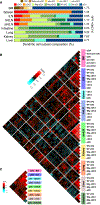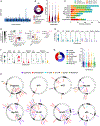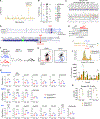Quantitative trait loci mapping provides insights into the genetic regulation of dendritic cell numbers in mouse tissues
- PMID: 38823019
- PMCID: PMC11726347
- DOI: 10.1016/j.celrep.2024.114296
Quantitative trait loci mapping provides insights into the genetic regulation of dendritic cell numbers in mouse tissues
Abstract
To explore the influence of genetics on homeostatic regulation of dendritic cell (DC) numbers, we present a screen of DCs and their progenitors in lymphoid and non-lymphoid tissues in Collaborative Cross (CC) and Diversity Outbred (DO) mice. We report 30 and 71 loci with logarithm of the odds (LOD) scores >8.18 and ranging from 6.67 to 8.19, respectively. The analysis reveals the highly polygenic and pleiotropic architecture of this complex trait, including many of the previously identified genetic regulators of DC development and maturation. Two SNPs in genes potentially underlying variation in DC homeostasis, a splice variant in Gramd4 (rs235532740) and a missense variant in Orai3 (rs216659754), are confirmed by gene editing using CRISPR-Cas9. Gramd4 is a central regulator of DC homeostasis that impacts the entire DC lineage, and Orai3 regulates cDC2 numbers in tissues. Overall, the data reveal a large number of candidate genes regulating DC homeostasis in vivo.
Keywords: CP: Immunology; Collaborative Cross; DCpoiesis; Diversity Outbred; QTL mapping; dendritic cell homeostasis; dendritic cell lineage; dendritic cell progenitors; dendritic cell subsets; immunogenetics; tissue distribution.
Copyright © 2024 The Authors. Published by Elsevier Inc. All rights reserved.
Conflict of interest statement
Declaration of interests The authors declare no competing interests.
Figures






Similar articles
-
Which mouse multiparental population is right for your study? The Collaborative Cross inbred strains, their F1 hybrids, or the Diversity Outbred population.G3 (Bethesda). 2023 Apr 11;13(4):jkad027. doi: 10.1093/g3journal/jkad027. G3 (Bethesda). 2023. PMID: 36735601 Free PMC article.
-
High-resolution genetic mapping in the diversity outbred mouse population identifies Apobec1 as a candidate gene for atherosclerosis.G3 (Bethesda). 2014 Oct 23;4(12):2353-63. doi: 10.1534/g3.114.014704. G3 (Bethesda). 2014. PMID: 25344410 Free PMC article.
-
The transcription factor C/EBPβ orchestrates dendritic cell maturation and functionality under homeostatic and malignant conditions.Proc Natl Acad Sci U S A. 2020 Oct 20;117(42):26328-26339. doi: 10.1073/pnas.2008883117. Epub 2020 Oct 5. Proc Natl Acad Sci U S A. 2020. PMID: 33020261 Free PMC article.
-
Origin and development of dendritic cells.Immunol Rev. 2010 Mar;234(1):45-54. doi: 10.1111/j.0105-2896.2009.00879.x. Immunol Rev. 2010. PMID: 20193011 Review.
-
Origin and functional heterogeneity of non-lymphoid tissue dendritic cells in mice.Immunol Rev. 2010 Mar;234(1):55-75. doi: 10.1111/j.0105-2896.2009.00885.x. Immunol Rev. 2010. PMID: 20193012 Review.
Cited by
-
Characterization of TLR9 responsiveness in cell subsets derived from in vitro pDC differentiation of hematopoietic stem and progenitor cells.Front Immunol. 2025 Mar 27;16:1550397. doi: 10.3389/fimmu.2025.1550397. eCollection 2025. Front Immunol. 2025. PMID: 40213544 Free PMC article.
-
Efficient genes identification via quantitative trait loci analysis by crossbreeding of sake and laboratory yeast.Appl Microbiol Biotechnol. 2025 Apr 8;109(1):84. doi: 10.1007/s00253-025-13470-w. Appl Microbiol Biotechnol. 2025. PMID: 40198396 Free PMC article.
References
Publication types
MeSH terms
Grants and funding
LinkOut - more resources
Full Text Sources
Molecular Biology Databases
Miscellaneous

